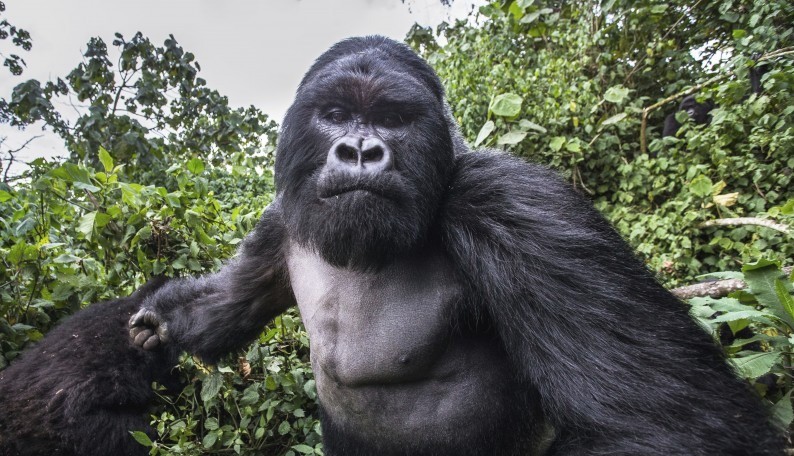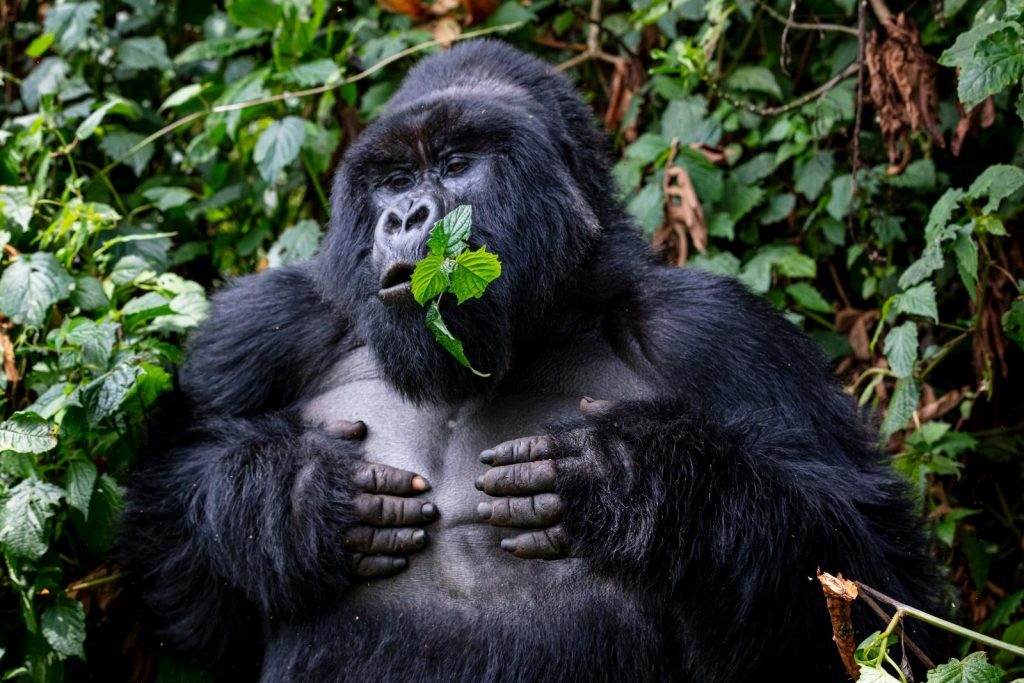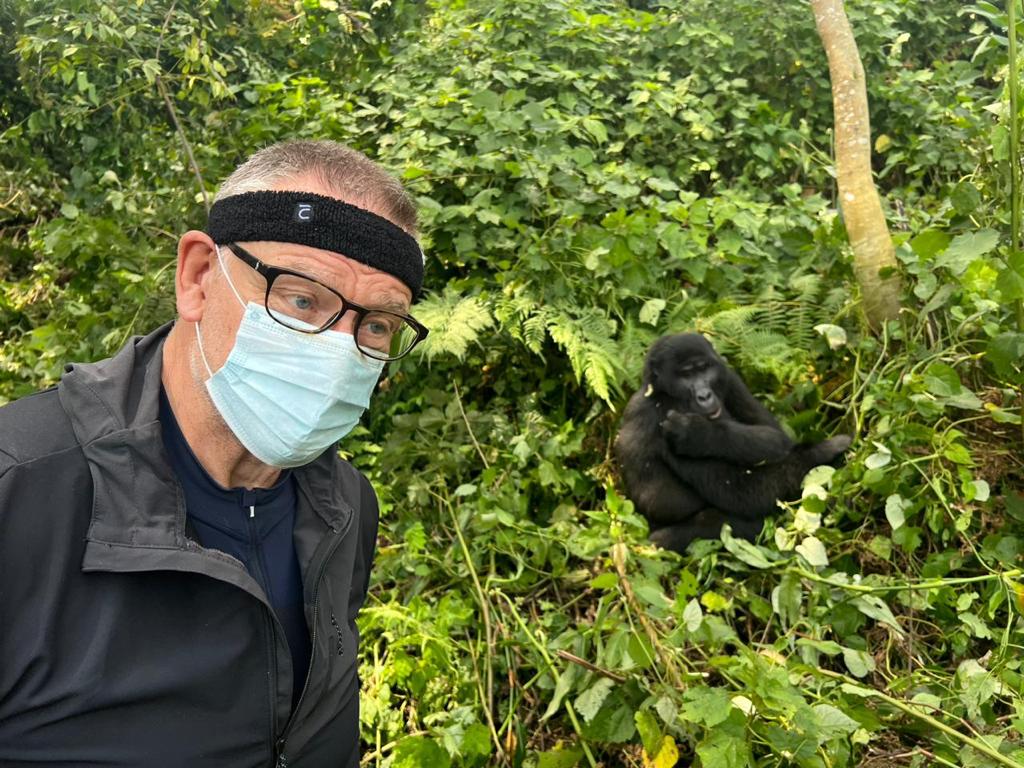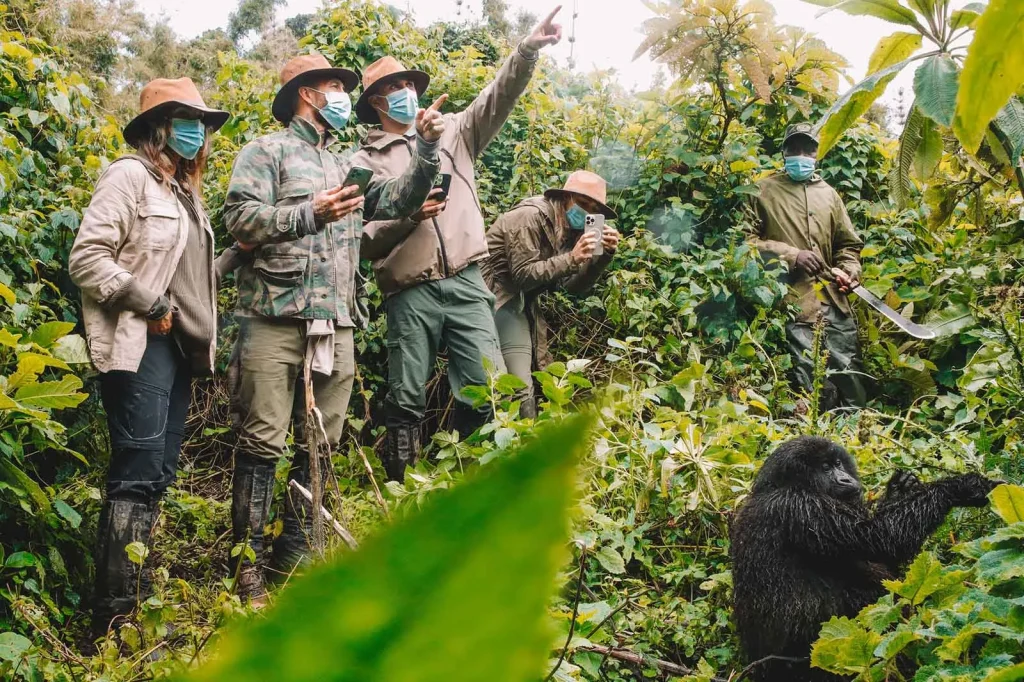Gorilla trekking in Rwanda’s Volcanoes National Park follows strict conservation-driven safety protocols and regulated visitor conduct. These guidelines protect both visitors and critically endangered mountain gorillas.
The Rwanda Development Board (RDB) enforces these rules to reduce human-wildlife contact and limit stress on the twelve habituated gorilla groups open to tourism.
One key focus is preventing the transmission of respiratory diseases between humans and gorillas, a known risk to primate populations. Current procedures reflect years of wildlife research and public health planning.
If you plan to participate, recognise that these protocols are not optional. Your compliance directly supports Rwanda’s ongoing gorilla conservation programs.
This guide outlines the essential aspects of gorilla trekking etiquette and safety in Rwanda, why each rule matters, and how you can contribute to responsible wildlife tourism.
Why Etiquette and Safety Matter in Gorilla Trekking
Mountain gorillas in Rwanda’s Volcanoes National Park remain one of Africa’s most closely monitored and biologically vulnerable wildlife populations. Conservation teams track their health and behaviour daily.
Although population numbers have shown gradual improvement over the past decade, these gorillas still face ongoing risks. Habitat limitations, disease exposure, and stress-induced behaviour shifts remain constant challenges.

Every visitor entering the gorilla habitat adds measurable biological and behavioural pressure. Factors like human scent, body posture, speaking volume, and even silent proximity can alter gorilla feeding, resting, or social patterns.
To manage these variables, the Rwanda Development Board enforces detailed etiquette and safety regulations for all visitors. These measures keep human-gorilla interaction within defined biological limits.
Following these protocols is not about formality. It represents the minimum behavioural standard necessary to protect group stability and reduce risks like aggression or forced displacement.
Besides risk management, etiquette demonstrates respect for the primates and their habitat. When visitors follow mask requirements, maintain correct viewing distances, and observe posture guidelines without complaint, they reinforce a shared conservation ethic.
Gorilla trekking in Rwanda is not a recreational entitlement. It remains a conservation-controlled privilege, granted under strict ecological conditions. Understanding this fact is part of what qualifies you to participate.
Gorilla Social Behaviour: Understanding Group Dynamics
In each habituated gorilla group within Rwanda’s Volcanoes National Park, a single dominant silverback holds authority. He controls group movement, monitors threats, and manages internal interactions.
His decisions determine when the group feeds, rests, or moves. Rangers observe his body language closely during treks to adjust visitor positioning and observation time.
Roles Within the Gorilla Family
Adult females form the reproductive core of the group. Infants, juveniles, and subadults contribute to social development through play, grooming, and group cohesion behaviours.
Each member responds instinctively to the silverback’s vocalisations, posture shifts, and movement pace. This internal structure helps maintain spatial awareness, even during visitor presence.
Gorilla Responses to Human Presence
Gorillas display a range of reactions when humans enter their space. Some remain neutral, while others show sensitivity through body language or repositioning.
For instance, a silverback may produce low vocalisations to calm his group or place himself between trekkers and younger individuals as a protective measure.
Recognising Signs of Discomfort
Visitors must watch for key behavioural signals. Rapid eye movements, chest beats, or mock charges indicate discomfort. These signals require immediate stillness and non-reactivity.

Rangers typically instruct visitors to lower their gaze, avoid sudden movements, and remain quiet until the silverback resumes calm behaviour.
Mandatory Safety Regulations for Gorilla Trekking Safety in Rwanda
Gorilla trekking in Rwanda’s Volcanoes National Park operates under a defined set of safety regulations. These rules align with veterinary research, field logistics, and primate behaviour studies.
The Rwanda Development Board (RDB) requires full visitor compliance, regardless of age, nationality, or previous trekking experience.
You will receive an official safety briefing at Kinigi Park Headquarters before departure, but understanding these core requirements in advance remains essential for your preparation.
- Maintain a Minimum Distance of Seven Meters
All visitors must remain at least seven meters away from gorillas at all times. This distance minimises disease transmission risk, particularly respiratory infections, which can spread through droplets. Close contact may also trigger spatial stress in gorillas, especially when infants are present. If a gorilla approaches, remain still and avoid direct eye contact. - Observe the One-Hour Viewing Limit
Trekkers may spend a maximum of 60 minutes observing a gorilla family. Rangers begin timing once the group reaches the gorillas. This limit helps reduce stress and behavioural disruption. Field studies confirm that shorter viewing periods lower the risk of human-induced changes in gorilla routines. - Respect the Eight-Person Group Size
Each gorilla family may host a maximum of eight trekkers per day. This cap controls noise levels, physical movement, and crowding around the animals. Rangers and porters accompany the group, but the eight-person limit applies strictly to paying guests. - Wear a Face Mask During Gorilla Viewing
Wearing a surgical mask or approved face covering remains mandatory while near the gorillas. This policy, introduced during the COVID-19 pandemic, continues to protect against respiratory infections. Rangers will remind you to wear the mask throughout the one-hour observation window. Extra masks are typically available at the briefing site. - Follow the Minimum Age Requirement of 15 Years
Only individuals aged 15 and above may participate in gorilla trekking in Rwanda. This age restriction addresses both health concerns and behavioural predictability. Younger children may struggle with trail conditions or react unpredictably during gorilla encounters. - Do Not Participate if You Are Unwell
Visitors showing symptoms of colds, flu, or other respiratory illnesses may not participate in gorilla trekking. Morning health checks include verbal screening and visual observation by park rangers. Guests with symptoms may be reassigned or offered alternative activities, depending on park policy. Your honesty remains vital for the safety of Rwanda’s gorillas. - Follow Park Rules on Restricted Items and Behaviour
Food, drinks, smoking materials, drones, and flash photography are prohibited during the trek and at the viewing site. These items disrupt gorilla behaviour and introduce unnecessary risk. Rangers will also enforce rules against loud talking, sudden movements, and imitating gorilla sounds. Non-compliance may result in termination.
How to Conduct Yourself Around Gorillas
Maintaining proper behaviour during the one-hour observation period reflects your understanding of gorilla trekking etiquette and safety in Rwanda. Every action you take influences how the gorillas interpret your presence.
Start by keeping your voice consistently low. Sudden changes in volume or outbursts create unnecessary vocal pressure that gorillas often interpret as stress signals. Group formation matters just as much. Staying close together allows gorillas to track your location easily, reducing the chance of misreading your presence as a threat.
During the encounter, avoid making direct eye contact with the silverback. In gorilla communication, prolonged staring signals confrontation. If a gorilla moves toward you, remain still and adopt a low crouching position. This simple posture communicates non-aggression and allows the animal to pass without alarm.
Handle cameras, bags, and other gear with deliberate care. Quick movements or sudden rustling can startle younger gorillas or attract the curiosity of juveniles. Allow the ranger to dictate all visitor movements throughout the encounter. Their experience with group dynamics allows them to assess when repositioning is necessary.
If the ranger asks you to step back, do so slowly and calmly. Rapid retreats can trigger defensive reactions from adult males. Also, secure any loose items before arriving at the observation site. Falling objects or dangling equipment create distractions that can affect the group’s mood.
Finally, resist the urge to point, wave, or mimic gorilla sounds. Even subtle gestures may disrupt the group’s focus or trigger dominance displays. By following these behavioural guidelines, you help protect both yourself and Rwanda’s gorillas from avoidable stress.
Hygiene and Health Protocols to Protect Rwanda’s Mountain Gorillas
Respiratory diseases represent the most significant cross-species threat during gorilla trekking in Rwanda.
Mountain gorillas share over 98 per cent of their DNA with humans, making them highly susceptible to many human pathogens, especially airborne viruses and bacterial infections.
Mild or asymptomatic illnesses in humans can cause severe respiratory distress in gorillas. This vulnerability is well documented by wildlife veterinarians and forms the basis for strict health protocols enforced within Volcanoes National Park.
Visitors must wear surgical-grade face masks whenever within visual range of gorillas.

This practice limits the dispersion of aerosols and droplets that can carry infectious agents. Before each trek, rangers conduct health screenings to identify symptoms such as fever, coughing, or flu-like signs.
Individuals exhibiting such symptoms are barred from proceeding. The same policy applies to gastrointestinal illnesses, which also pose an infectious risk.
Though these restrictions may feel inconvenient, they reflect non-negotiable biosecurity measures. All personal items, including cameras and water bottles, must be handled hygienically and never placed on the forest floor or near gorilla feeding sites.
As a visitor, you play a crucial role in frontline disease prevention. Honesty about symptoms, careful handling of equipment, and strict adherence to ranger instructions represent minimum ethical standards.
Protecting a critically endangered species from pathogens it cannot resist is central to gorilla trekking etiquette and safety in Rwanda. Effective biosecurity safeguards both gorilla health and the longevity of conservation efforts.
Upholding Responsibility for Gorilla Conservation and Safety when trekking
Every authorised gorilla trek in Rwanda operates within a narrow margin of biological tolerance. Conservation authorities, researchers, and rangers have developed protocols that enable human presence without causing ecological harm.
Tourists who enter this space assume a specific responsibility. They must act in ways that uphold safety, respect gorilla autonomy, and preserve ongoing scientific research.

The effectiveness of this conservation model depends not only on strict enforcement but also on informed understanding. When each participant embraces their role in the broader preservation framework, mountain gorillas gain a stronger chance to thrive where they belong: in the wild, under vigilant protection, and free from preventable threats.
For those committed to responsible gorilla trekking etiquette and safety in Rwanda, Inmersion Africa Journeys provides expertly guided experiences that align with these conservation principles, ensuring every visit supports long-term protection efforts.
Contact and Book with us today.
🐾 Email: info@inmersionafrica.com
🌿 Phone: +250 784 988 972
